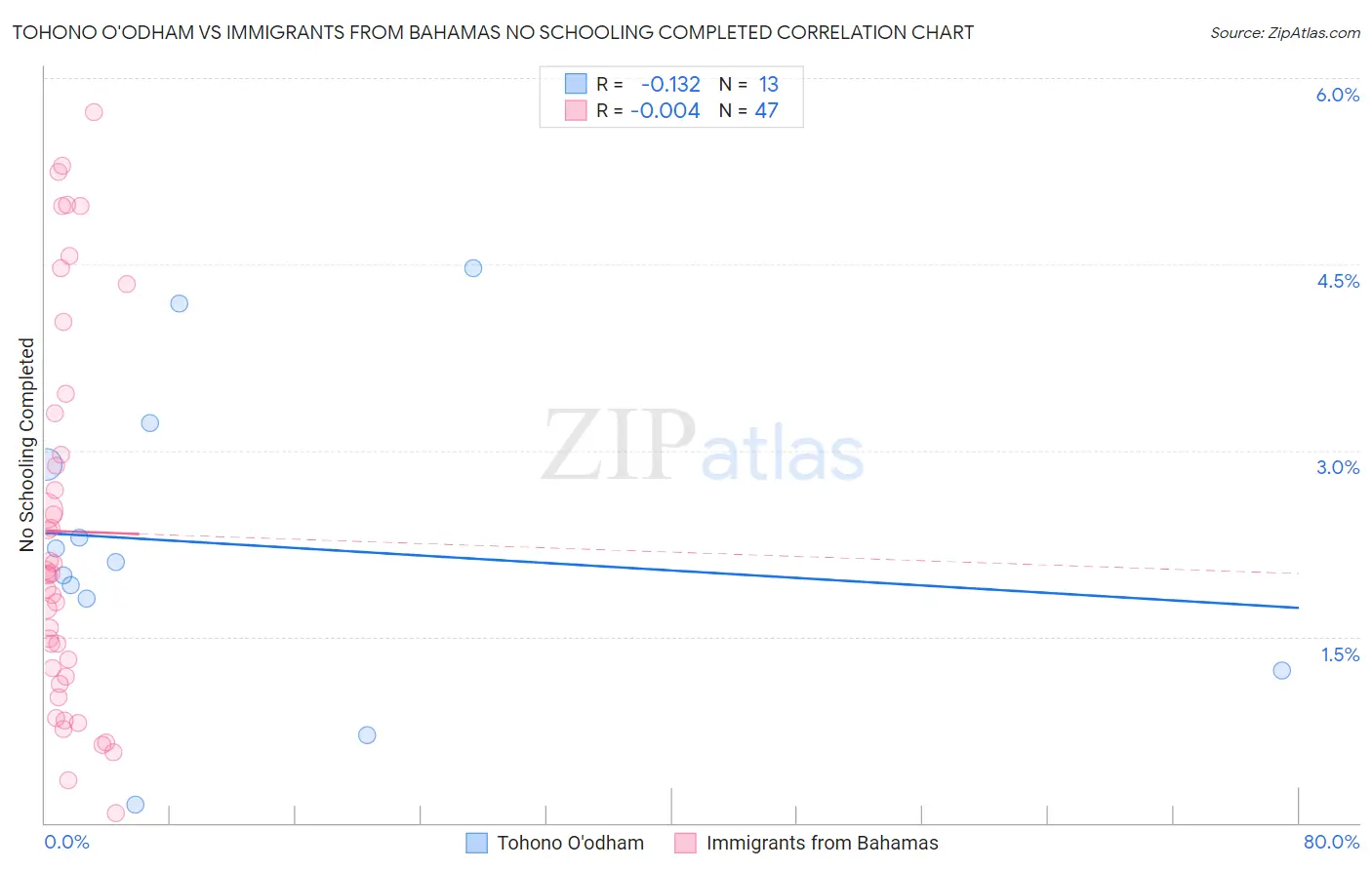Tohono O'odham vs Immigrants from Bahamas No Schooling Completed
COMPARE
Tohono O'odham
Immigrants from Bahamas
No Schooling Completed
No Schooling Completed Comparison
Tohono O'odham
Immigrants from Bahamas
2.3%
NO SCHOOLING COMPLETED
4.1/ 100
METRIC RATING
224th/ 347
METRIC RANK
2.2%
NO SCHOOLING COMPLETED
11.6/ 100
METRIC RATING
205th/ 347
METRIC RANK
Tohono O'odham vs Immigrants from Bahamas No Schooling Completed Correlation Chart
The statistical analysis conducted on geographies consisting of 58,626,316 people shows a poor negative correlation between the proportion of Tohono O'odham and percentage of population with no schooling in the United States with a correlation coefficient (R) of -0.132 and weighted average of 2.3%. Similarly, the statistical analysis conducted on geographies consisting of 104,436,270 people shows no correlation between the proportion of Immigrants from Bahamas and percentage of population with no schooling in the United States with a correlation coefficient (R) of -0.004 and weighted average of 2.2%, a difference of 3.5%.

No Schooling Completed Correlation Summary
| Measurement | Tohono O'odham | Immigrants from Bahamas |
| Minimum | 0.14% | 0.079% |
| Maximum | 4.5% | 5.7% |
| Range | 4.3% | 5.6% |
| Mean | 2.2% | 2.3% |
| Median | 2.1% | 2.0% |
| Interquartile 25% (IQ1) | 1.5% | 1.2% |
| Interquartile 75% (IQ3) | 3.1% | 3.3% |
| Interquartile Range (IQR) | 1.5% | 2.1% |
| Standard Deviation (Sample) | 1.2% | 1.5% |
| Standard Deviation (Population) | 1.2% | 1.5% |
Demographics Similar to Tohono O'odham and Immigrants from Bahamas by No Schooling Completed
In terms of no schooling completed, the demographic groups most similar to Tohono O'odham are Immigrants from Lebanon (2.3%, a difference of 0.29%), Subsaharan African (2.3%, a difference of 0.44%), Immigrants from Sudan (2.3%, a difference of 0.61%), Immigrants from Costa Rica (2.3%, a difference of 0.71%), and Senegalese (2.3%, a difference of 0.97%). Similarly, the demographic groups most similar to Immigrants from Bahamas are Bahamian (2.2%, a difference of 0.010%), South American Indian (2.2%, a difference of 0.19%), Uruguayan (2.2%, a difference of 0.19%), Hopi (2.2%, a difference of 0.40%), and Immigrants from Oceania (2.2%, a difference of 0.45%).
| Demographics | Rating | Rank | No Schooling Completed |
| Hopi | 12.9 /100 | #204 | Poor 2.2% |
| Immigrants | Bahamas | 11.6 /100 | #205 | Poor 2.2% |
| Bahamians | 11.6 /100 | #206 | Poor 2.2% |
| South American Indians | 11.0 /100 | #207 | Poor 2.2% |
| Uruguayans | 11.0 /100 | #208 | Poor 2.2% |
| Immigrants | Oceania | 10.2 /100 | #209 | Poor 2.2% |
| Natives/Alaskans | 10.0 /100 | #210 | Tragic 2.2% |
| Immigrants | Panama | 8.8 /100 | #211 | Tragic 2.3% |
| Immigrants | Morocco | 8.7 /100 | #212 | Tragic 2.3% |
| Ute | 8.2 /100 | #213 | Tragic 2.3% |
| Samoans | 8.2 /100 | #214 | Tragic 2.3% |
| Immigrants | Zaire | 7.2 /100 | #215 | Tragic 2.3% |
| Tongans | 6.8 /100 | #216 | Tragic 2.3% |
| Immigrants | Syria | 6.6 /100 | #217 | Tragic 2.3% |
| Immigrants | Nepal | 6.4 /100 | #218 | Tragic 2.3% |
| Senegalese | 5.6 /100 | #219 | Tragic 2.3% |
| Immigrants | Costa Rica | 5.1 /100 | #220 | Tragic 2.3% |
| Immigrants | Sudan | 5.0 /100 | #221 | Tragic 2.3% |
| Sub-Saharan Africans | 4.7 /100 | #222 | Tragic 2.3% |
| Immigrants | Lebanon | 4.5 /100 | #223 | Tragic 2.3% |
| Tohono O'odham | 4.1 /100 | #224 | Tragic 2.3% |